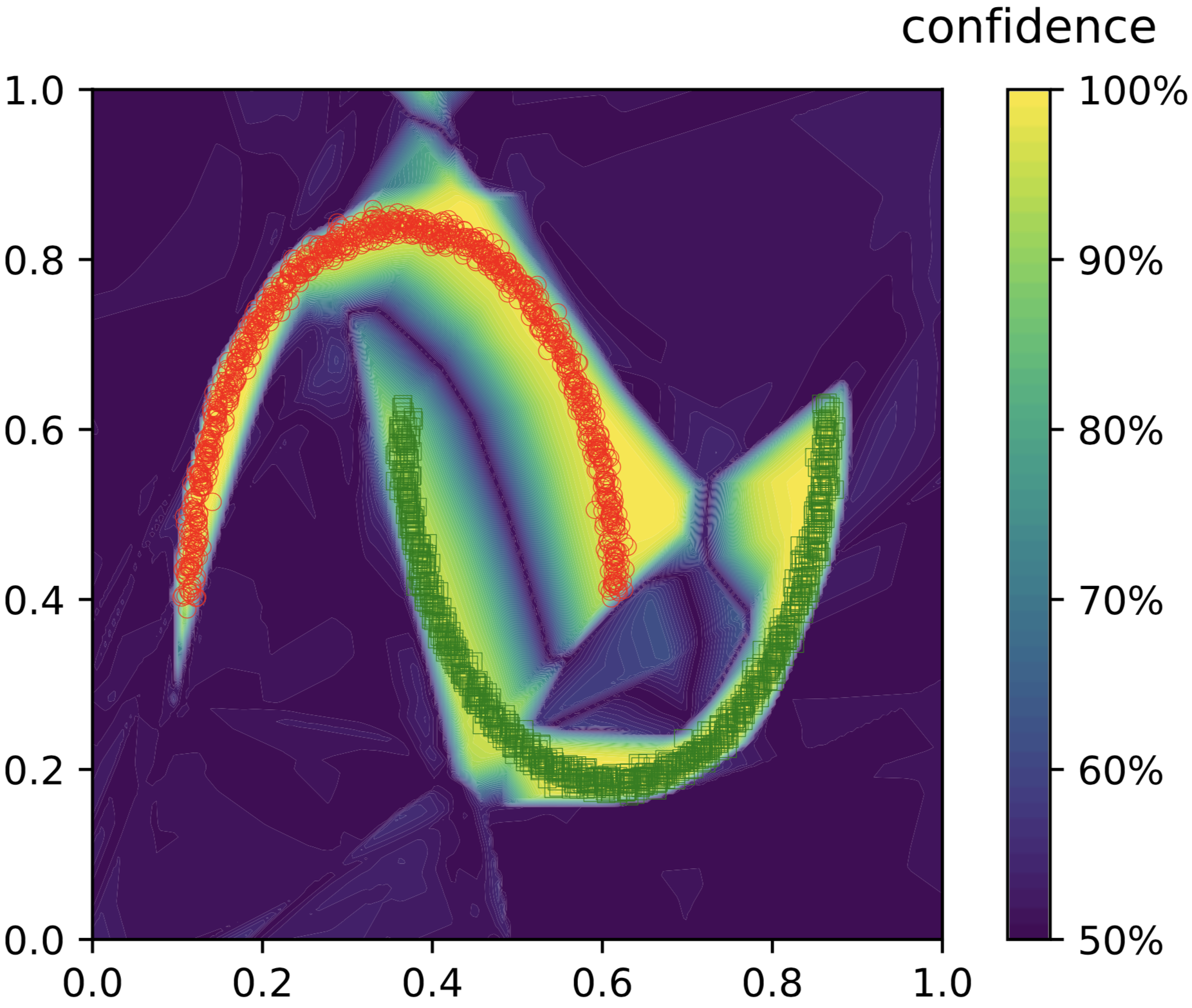Why ReLU networks yield high-confidence predictions far away from the training data and how to mitigate the problem
CVPR 2019 (accepted with an oral)
Matthias Hein, Maksym Andriushchenko, Julian Bitterwolf
University of Tübingen and Saarland University
https://arxiv.org/abs/1812.05720
ReLU-networks yield overconfident predictions on unrelated tasks. Here a ResNet-18 was trained on CIFAR-10 and evaluated on SVHN perceives digits as dogs, birds or airplanes with 100% confidence. Clearly, this questions the usage of neural networks for safety-critical tasks.
We can clearly see this on the two moons dataset: the classifier outputs 100% confidence almost everywhere, no matter how far away the points are from the training data.
We give a theoretical argument of why ReLU activation function can lead to models with overconfident predictions far away from the training data. We leverage the fact that a ReLU network partitions the input space on the finite set of polytopes.
The intuition is made formal in the main theorem.
In order to mitigate this problem, we propose a training scheme CEDA that enforces uniform confidences on out-of-distribution noise shown below.
We can see that CEDA already improves on the problem by preventing overconfident predictions.
Next we propose a robust optimization training scheme ACET which minimizes the worst-case noise in a neighbourhood of noise points. This works even better.
Although, as predicted by Theorem 1, overconfident predictions still exist since this is an inherent property of ReLU-networks regardless of the training procedure. If we zoom out from [0, 1] (where we sampled the uniform noise) to [-10, 10], we can clearly see that overconfident predictions are still there.
We provide a systematic comparison of ACET over plain and CEDA models on various benchmarks: from evaluation on noise to out-of-distribution detection on other image datasets.
We also illustrate the advantage of ACET on per-image basis. For example, if we train a plain model on MNIST and evaluate it on CIFAR-10, it is also prone to overconfident predictions (up to 99.6%) on images that do not have anything in common with digits.
However, ACET mitigates this problem to a large extent.
Finally, we illustrate Theorem 3.1 experimentally. We observe that simple alpha-scaling (i.e. brightness increase) of, e.g., uniform noise can easily lead to overconfident predictions for plain models even in the image domain [0, 1]^d. At the same time, ACET models helps to mitigate this problem as well.
toy2d.ipynb is a very short notebook that shows how to train an ACET model on two moons dataset.
For full-fledged code on how to train CNNs with ACET on multiple GPUs with tensorboard summaries,
please take a look onto train.py.
Models are created and trained by using the train.py script. Get the list of possible arguments via python3 train.py --help.
The value of at_frac determines the number of noise examples (on which the maximal confidence should be small) per clean training example. Thus, if --at_frac=0, a plain model will be trained.
For the CEDA and ACET models we report in the paper, we set --at_frac=1, which means 50% clean and 50% (adversarial) noise images.
The value pgd_niter determines how many steps of pgd will be applied to the noise. If its value is zero, the first random step will not be applied and just the noise will be used -- this is the correct setting for CEDA training.
For ACET, the parameters at_frac, pgd_niter and pgd_eps should be positive. In the paper, we used pgd_niter=40 and pgd_eps=0.3. While for plain and CEDA training the value of pgd_eps is not used, you can set it to compare their TensorBoard evaluations. As an example, for training the ACET model on SVHN we used the following command:
python3 train.py --exp_name='acet_svhn' --gpus=0 --n_epochs=100 --dataset=svhn --model=resnet_small --loss='max_conf' --opt=momentum --lr=0.1 --lmbd=0.0005 --pgd_eps=0.3 --at_frac=1 --pgd_niter=40
You can find all the models presented in Table 1 in the folder exps_paper.
The file names of the models contain the hyperparameters used for their training. For example:
2019-04-04 16:27:49_dataset=cifar100 model=resnet_small p_norm=inf lmbd=0.0005 at_frac=1.0 pgd_eps=0.3 pgd_niter=40 frac_perm=0.5 loss=max_conf
means that the model was trained on CIFAR-100, the architecture was resnet_small (see models.ResNetSmall
for its definition), ACET was applied on 50% examples in every batch (at_frac=1.0) wrt the Linf-norm eps=0.3, where
the 40 steps of PGD were used in the robust optimization procedure. The loss function used in PGD was the maximum
log probability taken over all classes.frac_perm=0.5 means that the noise is generated
with 50% uniform and 50% permutation noise.
Evaluation is split into two parts: Collecting the model outputs on several datasets, including adversarial noise and adversarial samples, and analyzing the output numbers.
First, run evaluation.py with the chosen hyperparameter settings for the evaluation as well as the model folder and name as arguments. This will save the predictions in numpy files within the model folder. For calculating the resulting statistics and plotting histograms and ROC curves, call analysis.py on that same folder. The resulting numbers are appended to a specified .csv file in the main folder, while you can find the plots as .png files within the model folder.
python3 evaluation.py --model_folder "{model_folder}" --model_name "{model_name}" --model "{model_type}" --dataset "{model_set} --gpus=1 --at_frac=1 --pgd_niter=80 --pgd_eps "{eps}" --pgd_step "{step}" --loss='max_conf'
python3 analysis.py --model_folder "{model_folder}" --save_all_evals='results.csv'
During training, several metrics are recorded as TensorBoard logs, which can be reviewed with tensorboard --logdir=exps.
Our code runs on Python3.5. For the computations we use tensorflow:1.10.1 and dataloading is running with PyTorch version 0.4.1 and torchvision.
With Python3.5 installed, you can create a docker container that has all necessary dependencies installed by using the provided Dockerfile.
Please contact Maksym Andriushchenko or Julian Bitterwolf regarding this code.
@article{hein2019relu,
title={Why ReLU networks yield high-confidence predictions far away from the training data and how to mitigate the problem},
author={Hein, Matthias and Andriushchenko, Maksym and Bitterwolf, Julian},
conference={CVPR 2019},
year={2019}
}












